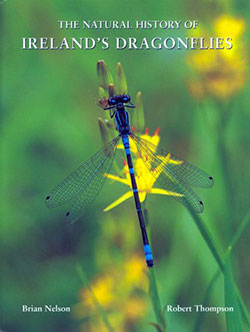The Natural History of Ireland’s Dragonflies
By Brian Nelson & Robert Thompson – (2004)
 454 pages; gloss art paper, with 332 high quality colour photographs, 5 monochrome photographs, 5 colour drawings, 7 tables, 54 graphs, 2 main maps, 10 survey interpretation maps, 32 distributional species maps & 52 small odonate observation location maps.
454 pages; gloss art paper, with 332 high quality colour photographs, 5 monochrome photographs, 5 colour drawings, 7 tables, 54 graphs, 2 main maps, 10 survey interpretation maps, 32 distributional species maps & 52 small odonate observation location maps.
Hard Cover: 28.2cm x 22.6cm
ISBN: 0-900761-45-8
The National Museums and Galleries of Northern Ireland
Very few odonate books (if any) are as lavishly presented and offer so much data on the individual species as this book does. This huge volume is the published result of the ‘DragonflyIreland’, 4 year research project conducted by various Irish scientific institutions. This stunningly illustrated book could also be considered as a subtle tourist attracting mechanism as it not only superbly covers all Irelands odonate species aesthetically and technically but further boons some of Ireland’s beautiful landscape.
The opening pages deal with odonate history and the Irish history, life cycle ecology, ‘DragonflyIreland’ project and its results, biogeography and a checklist. The section on the Irish history of odonate study is quite interesting with some nice insights and data about Mary Ball one of the first Irish naturalists and also the same applies to later naturalists and entomologists Cynthia Longfield accompanied with photos of her collecting in Brazil and also good data and a photo of Niall MacNeill.
In the main chapter of the species accounts each species has its common name, Irish name, scientific name author and year published, average overall length and wingspan in millimeters accompanied by quite full colour and physical descriptions, in depth discussion and hints to id similar species, behavior, estimates of local life cycle times, habitat, local natural history, distribution both locally and globally, and finally any miscellaneous notes and other relevant observations. The distribution of species for Ireland is enhanced with each species having a large colour coded dot map for where each species was collected and observed and the years done so for the duration of the ‘DragonflyIreland’ project. Further, each species description is adorned with some outstanding colour photographs of habitat, males, females and in some cases juveniles or intermediate forms and the photographs of the larvae are incredible, very clear and technically precise high quality photography including their print reproduction – really ‘top notch’.
This huge volume is written in such a way anyone can understand and make use of its text content from professional entomologists to the avid domestic fan. Moreover, the bulk of the photos of the odonates themselves are outstanding with some amazing close-ups, incorporated with rather inviting picturesque settings of the Irish country side subtly enticing us to visit not just to observe odonates but to also take in the Irish culture and hospitality.
Rod Rice
Principal Reviewer
Nature & Travel Books
